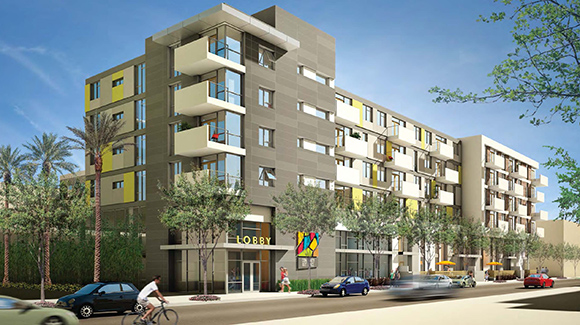
(Photo Credit: Meta Housing Corporation)
CandyJo Dahlstrom and her husband are working artists in Southern California. Like many, they are freelancers who live without a regular paycheck and often find themselves struggling to pay rent. But they are lucky, after finding a home and community in Glendale’s Ace 121, a new affordable housing complex for working artists.
“Everybody is struggling in this economy and then being an artist who doesn’t have consistent income it was always really hard for us to make rent and still be able to have any money to do anything on the side,” said Dahlstrom, who works as a make-up artist, costumer designer, dance instructor, while her husband teaches writing and acting.
She has three children and the family was living in a two-bedroom apartment before moving to Ace 121. “We’ve been barely scraping by paycheck to paycheck, even needing help from friends and family for the past couple years.”
“All communities in L.A. are in dire need of affordable housing,” said Michelle Coulter, project manager at Meta Housing Corporation, which developed the 70-unit complex. “Glendale took advantage of an opportunity and, given their unique partnership with the YMCA, this project was a serendipitous result of that opportunity.”
Ace 121 was built due to efforts by the City of Glendale to create an Arts District that includes theatres, galleries, nightlife and shopping, while also promoting a mixed-used, mixed-income neighborhood. Meta Housing Corporation developed Ace 121 with land provided by the Glendale YMCA and financing from the Glendale Housing Authority, Western Housing Community, Inc. and California tax credits.
Units range from $502-$909 for a one bedroom to $577-$1,254 for a three bedroom to ensure that the resident’s rent never exceeds 30 percent of their income. That’s compared to the market rates of the nearby Americana at Brand where one bedrooms go for $2,875 and two bedrooms go for $4,200 per month.
The complex is in the heart of downtown Glendale, close to transit and the business district with two large shopping malls and easy access to the YMCA. It includes amenities designed specifically for artists including an art gallery, art studios, a kiln, classroom space with a computer lab and music rooms. EngAGE, a non-profit dedicated to providing wellness, learning and creativity to senior affordable housing communities, has partnered with Meta to provide art programming at Ace 121, including classes, exhibitions and performances.
“What we’re here to do is to make this place great for the people who live here,” said Tim Carpenter, founder and executive director of EngAGE. “The way we’ve always worked with serving populations inside our buildings is to work with them and not at them. It’s all about creating something for the people who live here.” Although many of EngAGE’s projects are senior-based, Ace 121’s residents are working artists of all ages.
“I do think that there are huge partnerships here and I’ve been approached by numerous arts organizations who have a really high interest in working with the residents in this building as they see it as a way to take their work into that next extension,” said EngAGE Program Director Marshall Ayers.
Carpenter stresses the importance of developments such as Ace 121. “A project like this is great because you can provide affordable housing directly to artists and somewhat alleviates the gentrification that often forces artists out of areas. When you call something an ‘arts district’ or a ‘creative zone,’ often what happens is people move in and drive the rents up and the artists can’t live there anymore, so it’s this double-edge sword with the arts.”
And the recent Ghost Ship tragedy in Oakland underscores the need for artist housing. “The tragedy that happened in Oakland is a failure of the combination of affordable housing and providing a place for artists to be in the community. And this (Ace 121) could be the solution to that,” said Carpenter. “If there was an arts colony or an arts community in Oakland, they could have been living there instead of some terrible landlord’s squalor-filled place where they were being taken advantage of and put in a dangerous situation.”
Dahlstrom agrees: “It’s important to support the people in your community. If you’re going to be in a position of power, a community leader, that’s what you do. You’ve got to pay attention to what you’re community needs and to help provide in the best way you can.”
With more than a third of California's renters paying more than 50 percent of their income on housing, artists and others would stand to benefit from affordable units and also housing policies that help fill demand and take a bite out of the growing afforability problem. Ace 121 is a good example of placing affordable housing near transit and jobs as well as adding value to the neighborhood and community, which are included in the California Economic Summit’s Housing Action Plan.
“We feel it’s an important priority, especially given the importance of artists in L.A., frankly as an industry, this is so much a part of our industrial base,” said Coulter. “We’re not talking about creative communities just for the sake of creative communities, we’re talking about the industrial base for our (Los Angeles) County.”

